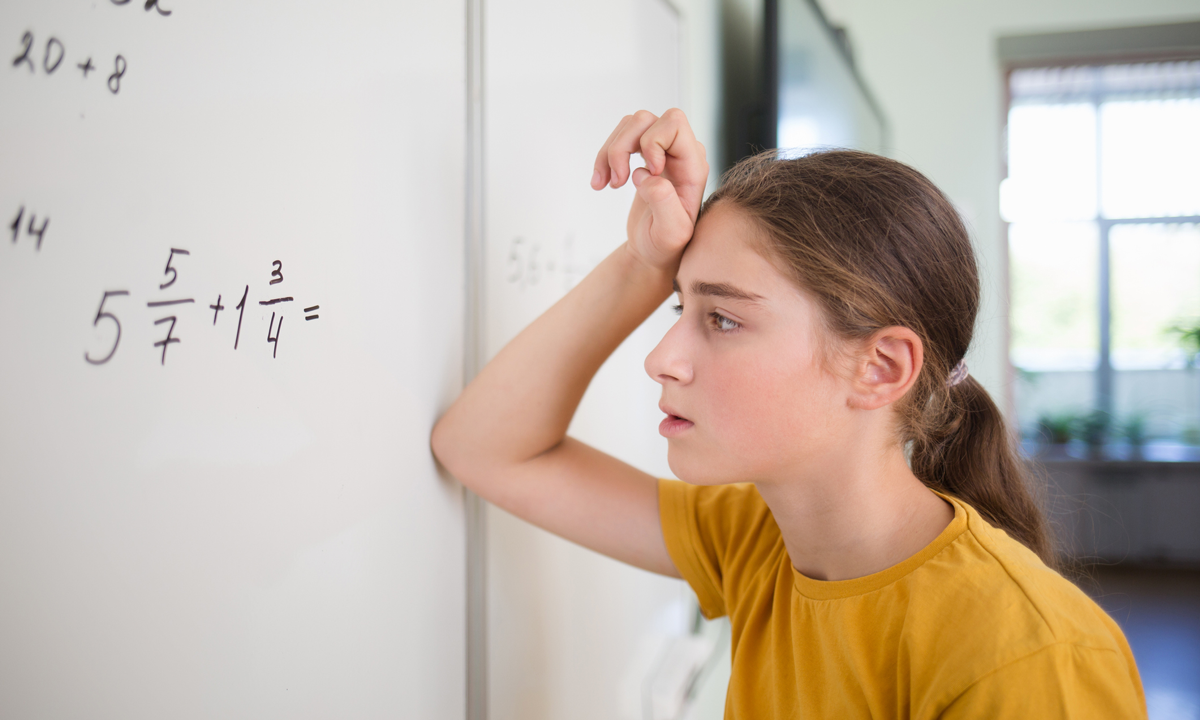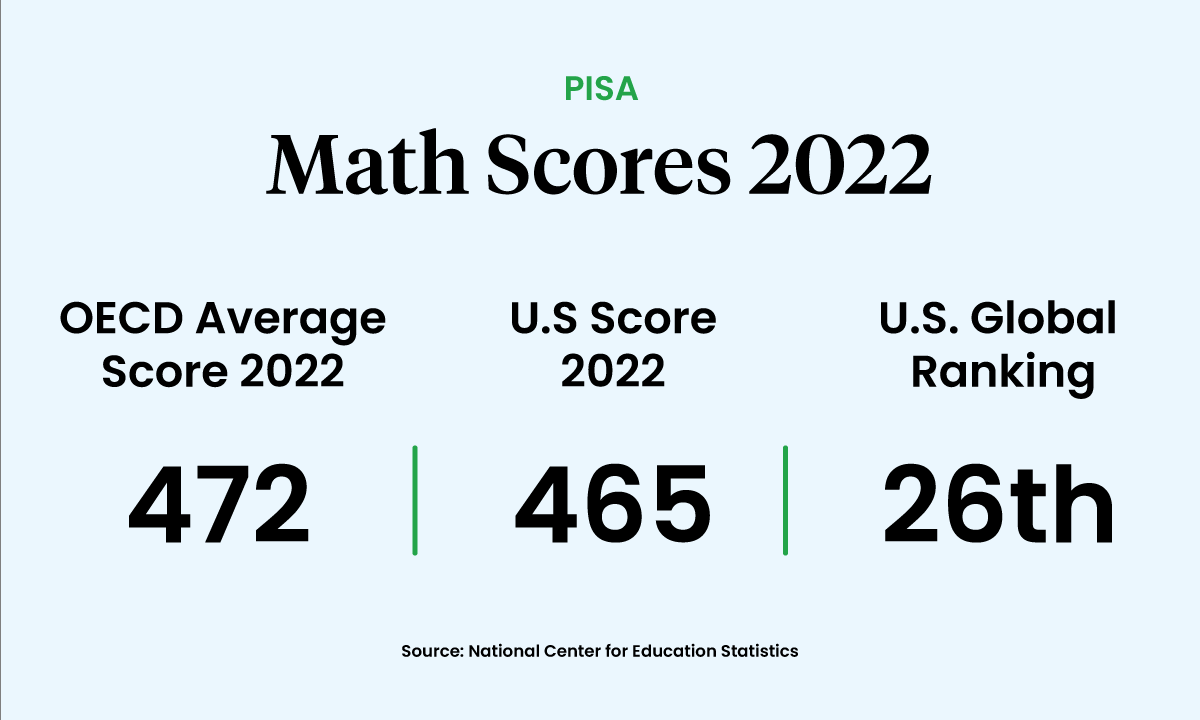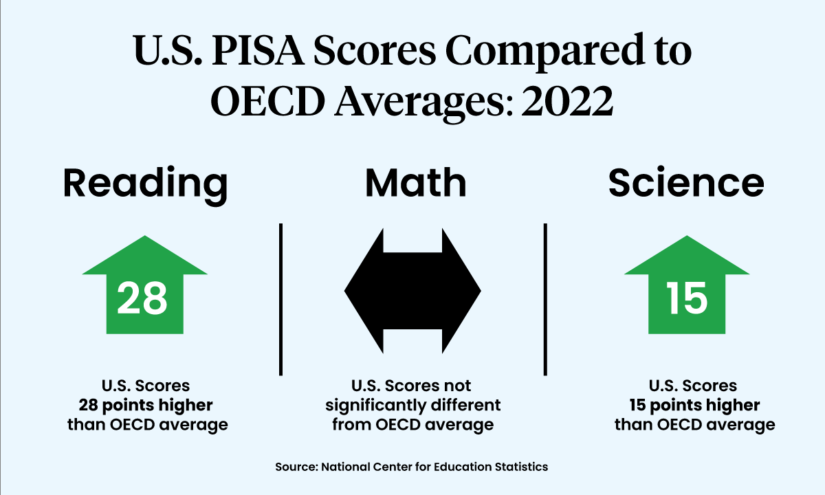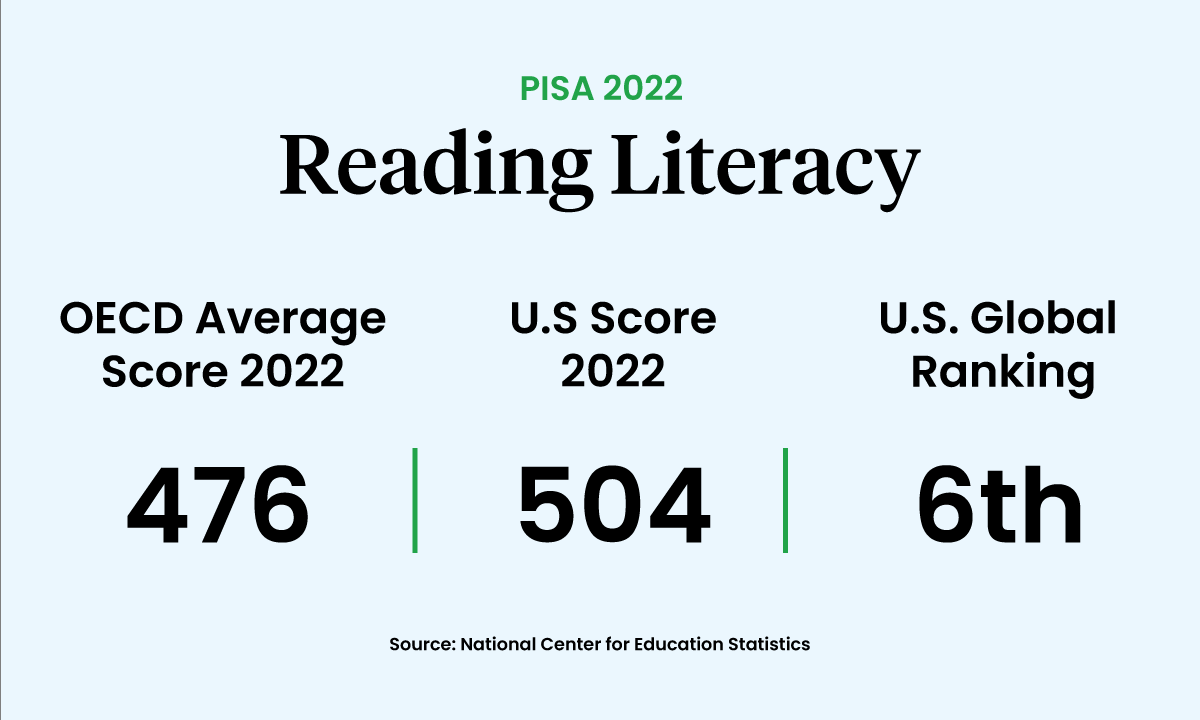American Math Scores Fall on International Test — But Many Other Countries Suffered More
The PISA test offers the latest evidence on COVID-related learning loss.

Get stories like this delivered straight to your inbox. Sign up for The 74 Newsletter
Math achievement tumbled for American 15-year-olds between 2018 and 2022, according to the latest results from the Program for International Student Assessment (PISA), an exam comparing academic performance in the U.S. against that of dozens of other countries. In an encouraging development, however, their reading and science skills appear to be undiminished over the last four years.
Announced Tuesday morning, the scores represent more proof of steep learning loss in math during the pandemic and its aftermath. But they also provide the first international context for COVID’s impact on American children, indicating that many students abroad — including in countries that have previously ranked among the world’s top performers — may have experienced even worse setbacks.
Eighty-one countries participated in PISA in 2022, according to the Organisation for Economic Co-operation and Development, the intergovernmental authority that administers the test. Among that group, average scores fell by 15 points in math and 10 points in reading since 2018, while science scores were not significantly changed.
As in several other standardized tests conducted since COVID’s emergence in 2020, those declines are unprecedented; over 20 years of PISA testing, average math and literacy scores have never moved by more than four or five points between consecutive assessments. Peggy Carr, commissioner of the U.S. Department of Education’s National Center for Education Statistics, told reporters on Monday that even highly developed countries across Europe and Asia “suffered tremendously” from the learning disruptions triggered by the pandemic.

“These results are another piece of evidence showing the crisis in mathematics achievement,” Carr said. “Only now can we see that it is a global concern.”
But while American students’ 13-point drop in math fell within the international average, their relative stasis in PISA’s other testing domains of reading and science (minus-one and minus-three points since 2018, neither of which is considered statistically significant) provide surprisingly positive news. Indeed, while U.S. scores slumped across all three subjects, the ranking of the United States among PISA participants actually improved since 2018: from 29th in mathematics to 26th, from eighth in reading to sixth, and from 11th in science to 10th.
Those shifts in relative performance result from even greater COVID-era slides in other countries. Among those seeing especially large reversals in math were Iceland (minus-36 points), Norway (minus-33 points), Poland (minus-27 points), and Slovenia (minus-24 points). Fifteen-year-olds in Finland, which has built an international reputation for top performance on exams like PISA, saw a 30-point drop in reading skills over the last four years.
In a somewhat curious turn, the index of four Chinese provinces where students have traditionally taken the PISA (Beijing, Shanghai, Jiangsu, and Zhejiang) did not report scores for the 2022 round. In previous administrations of the test, those students yielded the top scores on all three subjects — although those results were also criticized by international observers for allegedly being “cherry-picked” from China’s wealthiest and highest-achieving areas.

According to the OECD, the four provinces participated in the 2022 test, but their performance couldn’t be measured because schools were closed during the intended data collection period. Impressive scores were posted by students in the Chinese jurisdictions of Hong Kong and Macau, though these will likely also be considered atypical of learning across that country’s vast mainland.
Among PISA’s top-scoring nations in math were East Asian participants like Singapore, Hong Kong, Macau, Japan, Chinese Taipei (Taiwan), and Korea. Singapore, Ireland, Estonia, Japan, Korea, and Taiwan boasted the strongest readers.
‘I would have expected a larger drop.’
The scores will undoubtedly be used as an indicator of how learning was affected by COVID. Two-thirds of participating countries reported that they closed schools for longer than three months for the majority of their students during the pandemic. Students in countries that experienced briefer periods of closure did see smaller drops in math scores, the OECD reported, but Carr said the statistical correlation was “weak.”
A wealth of research conducted since 2020 has drawn close connections between virtual learning and academic harm. But prior standardized testing releases, such as that of the National Assessment of Educational Progress, have shown that states that kept schools open also endured significant learning damage, muddying the argument over the ultimate impact of shuttered schools.
In surveys accompanying the test, large numbers of American students reported that they’d experienced particularly lengthy school closures. Twenty percent said their school building had been closed between six and 12 months over the previous three years (compared with 15 percent of respondents across all OECD member nations), while another 20 percent said their school had closed for over a year (compared with just 12 percent of respondents across the OECD).
Tom Loveless, a researcher who previously headed the Brookings Institution’s Brown Center on Education Policy, said that America students’ math decline, while significant, was not “enormous.”

“Compared with the other OECD countries, we definitely had schools closed for a longer period of time,” Loveless said. “If you take this as a pre- and post-pandemic indicator, I would have expected a larger drop.”
Other learning observers were more bearish on the Americans’ showing, especially compared with comparable youths in countries far poorer than the U.S. Sal Khan, founder of the online learning platform Khan Academy, argued that the international averages concealed significant disparities between the highest- and lowest-achieving test takers.
“The results are disappointing, but not surprising, and consistent with all of the other data we’ve seen post-COVID,” Khan added in an email. “In general, I think the state of math education is pretty bad globally — but there is less of an excuse in wealthy countries like the United States.”
Whatever the prevailing trends in other countries, some in the K–12 policy community will agree with that glum appraisal. Overall, 34 percent of American test takers demonstrated only basic or below-basic math skills — slightly higher than the OECD average of 31 percent. And while their reading and science scores held their ground during the COVID era, they are also not measurably improved from the years when PISA first assessed those subjects (2000 and 2006, respectively.)
The findings also raise the question of how school leaders in the United States and other countries will boost student performance in the long run. Local and state test data in the U.S. confirm that many students are still performing substantially worse than children of the same age four years ago. And with the imminent expiration of federal emergency funds that have underwritten extra staffing and programs over the last several years, authorities will need to move fast to effect a turnaround.
Bob Hughes is the director of K–12 learning programs at the Bill & Melinda Gates Foundation, which has launched school reform and improvement efforts across the U.S. for over two decades. Last year, the organization announced that it would commit over $1 billion to improve math instruction by making the subject more engaging and relevant to students.
While calling the PISA scores “upsetting news,” Hughes added that schools and school districts could jump-start significant progress in math by employing a host of evidence-based strategies: high-impact tutoring for struggling students, improved professional learning for teachers, and more rigorous curricular materials (the “Singapore math” approach, which has shaped elementary math instruction in that country since the 1980s, has spawned a legion of fans in the U.S. as well).
“We actually have much better data than we’ve had in the past, and we have a clearer view of what the interventions need to be,” Hughes said. “We just need to get to the business of doing it rather than spending a lot of time wringing our hands.”
Disclosure: The Bill & Melinda Gates Foundation provides financial support to The 74.
Get stories like these delivered straight to your inbox. Sign up for The 74 Newsletter

;)
